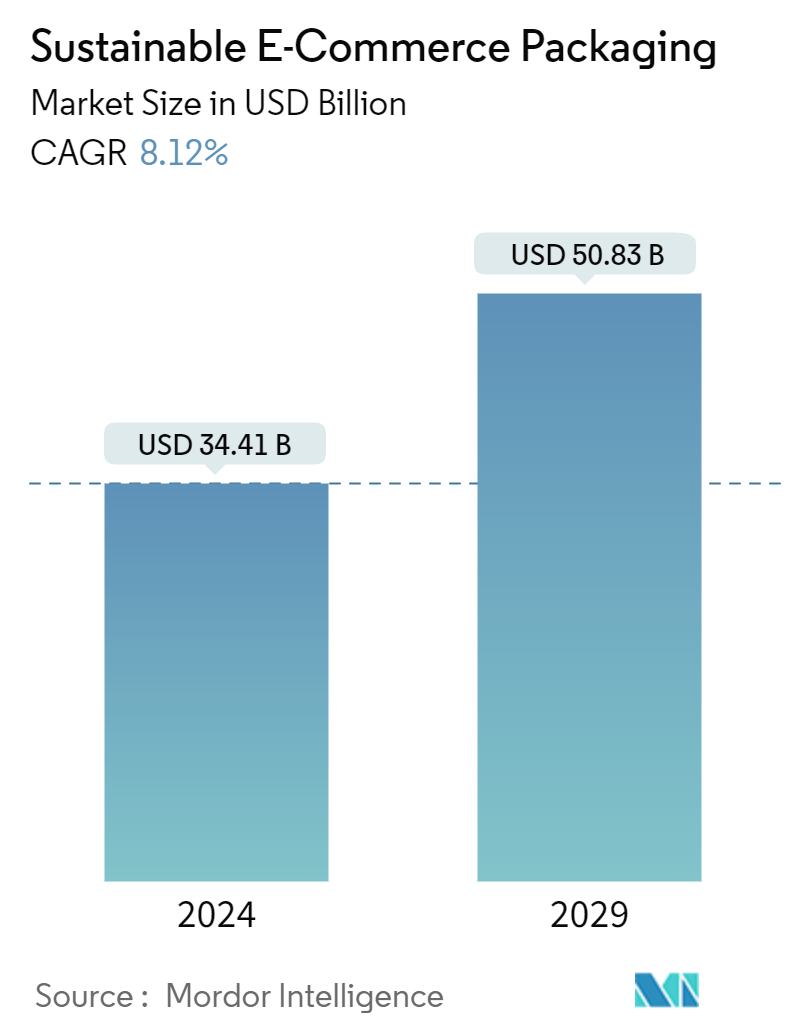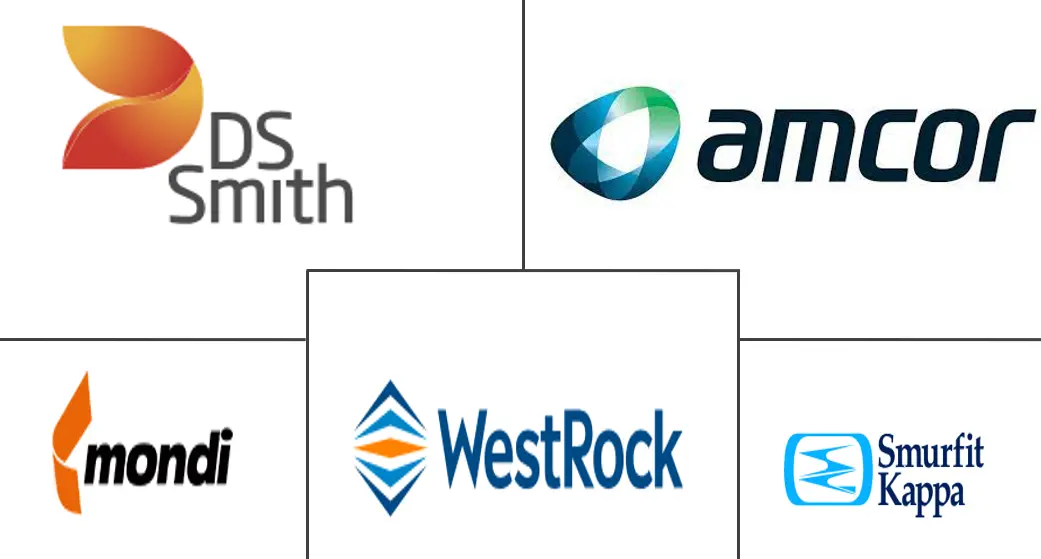Market Size of Sustainable E-Commerce Packaging Industry

| Study Period | 2019 - 2029 |
| Market Size (2024) | USD 34.41 Billion |
| Market Size (2029) | USD 50.83 Billion |
| CAGR (2024 - 2029) | 8.12 % |
| Fastest Growing Market | North America |
| Largest Market | Asia Pacific |
| Market Concentration | Low |
Major Players
*Disclaimer: Major Players sorted in no particular order |
Sustainable E-Commerce Packaging Market Analysis
The Sustainable E-Commerce Packaging Market size is estimated at USD 34.41 billion in 2024, and is expected to reach USD 50.83 billion by 2029, growing at a CAGR of 8.12% during the forecast period (2024-2029).
Manufacturers and consumers are becoming more aware of the environmental consequences of packaging waste, resulting in an incremental need for sustainable packaging solutions that reduce waste and utilize eco-friendly materials. The behavior of eco-conscious consumers in developed regions like Europe and North America gravitates toward environmentally sustainable packaging, which can be made from recycled, biodegradable, or compostable materials.
- Sustainability is a major driver of purchase decisions and brand affinity in e-commerce. Retailers and e-commerce packaging vendors are taking action by incorporating sustainable packaging choices like corrugated boxes made from recycled materials, paper-based alternatives, and simplistic designs that decrease material usage.
- E-commerce stakeholders substantially recognize the requirement to make sustainable packaging viable for small businesses that supply products to these platforms to achieve targets. This comes when multiple governments and individual retailers look for options to curb the usage of single-use plastic. Several e-commerce companies are banning single-use plastics in their packaging supply chain.
- For instance, in July 2023, Walmart unveiled its groundbreaking decision to help make the everyday shopping experience more sustainable by reducing packaging waste related to online purchases. The firm is moving from plastic to recyclable paper mailers. Rightly-sized cardboard box packaging would allow customers to consolidate shipping on e-commerce orders and eliminate the use of disposable plastic bags. This switchover was estimated to remove 65 million single-use plastic bag mailers, or over 2,000 metric tons of plastic waste, from United States landfills by the end of 2023.
- The past few years have seen a continual consumer purchasing shift toward e-commerce and away from brick-and-mortar stores. The use of online shopping in the United States has been increasing in the past few years. According to the US Census Bureau, e-commerce retail sales as a percentage of total retail sales in the United States increased from 9.1% in 2017 to 15.4% in 2023. The surge in online purchases necessitates the need for effective, eco-friendly, and sustainable packaging choices.
- However, fluctuations in the raw material prices backed by the constant supply chain-related issues caused by sudden geopolitical events (like the conflict between Ukraine and Russia and other trade tensions between countries) may dent the market's top line in the upcoming period. Fluctuations in the prices of raw materials have the potential to impact the total production expenses and subsequently impact the ultimate pricing of the completed products or services.
- As the e-commerce sector grows, technological advancements are being developed to ensure customer safety and security. Examples of such advances include shipment applications facilitated by sustainable RF and RFID labels, which help track the product, the manufacturer's facility, the information of the delivery partner, and the shipper’s warehouse. Online shopping is becoming increasingly popular in both developed and emerging markets like Indonesia, India, etc., and customers are taking advantage of convenient packaging solutions that monitor product information during the shipment and delivery process, providing lucrative market opportunities.
Sustainable E-Commerce Packaging Industry Segmentation
Based on current trends and market dynamics, the study tracks and analyzes the demand for sustainable e-commerce packaging within the end-user industry. The market numbers are derived by tracking the revenue generated by players providing sustainable e-commerce products across the end-user industries in the retail sector. The study provides a detailed breakdown of the various types of material across different geographies. This report analyzes the factors based on the prevalent base scenarios, key themes, and end-user vertical-related demand cycles.
The report covers sustainable e-commerce packaging companies. The market is segmented by material type (plastic, paper, and paper board metals), end user (fashion and apparel, consumer electronics, food and beverage, pharmaceuticals, personal care, and other end users), and geography (North America (United States and Canada), Europe (United Kingdom, Germany, France, Italy, Spain, and Rest of Europe), Asia-Pacific (China, India, Japan, Australia, and Rest of Asia-Pacific), Latin America (Brazil, Mexico, Argentina, and Rest of Latin America), Middle East and Africa (United Arab Emirates, Saudi Arabia, South Africa, and Rest of Middle East and Africa). The report offers market sizes and forecasts in value (USD) for all the above segments.
| By Material Type | |
| Plastic | |
| Paper and Paper Board | |
| Metal |
| By End User | |
| Fashion and Apparel | |
| Consumer Electronics | |
| Food and Beverage | |
| Pharmaceuticals | |
| Personal Care |
| By Geography | |||||||
| |||||||
| |||||||
| |||||||
| |||||||
|
Sustainable E-Commerce Packaging Market Size Summary
The Sustainable E-Commerce Packaging Market is experiencing significant growth, driven by increasing awareness of environmental issues and the demand for eco-friendly packaging solutions. As consumers and manufacturers become more conscious of the environmental impact of packaging waste, there is a growing preference for sustainable options made from recycled, biodegradable, or compostable materials. This shift is particularly evident in developed regions such as Europe and North America, where eco-conscious consumer behavior is influencing purchasing decisions. Retailers and e-commerce packaging vendors are responding by incorporating sustainable materials and designs that minimize waste, aligning with the broader trend of reducing single-use plastics. The rise of e-commerce, accelerated by the COVID-19 pandemic, has further amplified the need for effective and sustainable packaging solutions to accommodate the increasing volume of online purchases.
The market is characterized by a fragmented landscape with major players like Amcor Group GmbH, Smurfit Kappa Group, WestRock Company, and DS Smith PLC leading the charge in sustainable packaging innovations. These companies are actively pursuing strategic partnerships and acquisitions to enhance their offerings and expand their market presence. For instance, Smurfit Kappa's acquisition of WestRock aims to create a leading global paper packaging company, while Procter & Gamble's collaboration with Dow focuses on reducing packaging material weight. The market's growth is also supported by technological advancements in packaging solutions, such as sustainable RF and RFID labels, which enhance product tracking and information sharing during the shipping process. Despite challenges like raw material price fluctuations and geopolitical supply chain issues, the demand for sustainable e-commerce packaging continues to rise, driven by regulatory pressures and consumer preferences for environmentally friendly products.
Sustainable E-Commerce Packaging Market Size - Table of Contents
-
1. MARKET INSIGHTS
-
1.1 Market Overview
-
1.2 Industry Attractiveness - Porter's Five Forces Analysis
-
1.2.1 Bargaining Power of Buyers
-
1.2.2 Bargaining Power of Suppliers
-
1.2.3 Threat of Substitutes
-
1.2.4 Threat of New Entrants
-
1.2.5 Intensity of Competitive Rivalry
-
-
1.3 Industry Value Chain Analysis
-
1.4 Assessment of Impact of Recent Geopolitical Scenario on the Industry
-
-
2. MARKET SEGMENTATION
-
2.1 By Material Type
-
2.1.1 Plastic
-
2.1.2 Paper and Paper Board
-
2.1.3 Metal
-
-
2.2 By End User
-
2.2.1 Fashion and Apparel
-
2.2.2 Consumer Electronics
-
2.2.3 Food and Beverage
-
2.2.4 Pharmaceuticals
-
2.2.5 Personal Care
-
-
2.3 By Geography
-
2.3.1 North America
-
2.3.1.1 United States
-
2.3.1.2 Canada
-
-
2.3.2 Europe
-
2.3.2.1 United Kingdom
-
2.3.2.2 Germany
-
2.3.2.3 France
-
2.3.2.4 Italy
-
2.3.2.5 Spain
-
-
2.3.3 Asia-Pacific
-
2.3.3.1 China
-
2.3.3.2 Japan
-
2.3.3.3 India
-
2.3.3.4 Australia and New Zealand
-
-
2.3.4 Latin America
-
2.3.4.1 Brazil
-
2.3.4.2 Argentina
-
2.3.4.3 Mexico
-
-
2.3.5 Middle East and Africa
-
2.3.5.1 Saudi Arabia
-
2.3.5.2 United Arab Emirates
-
2.3.5.3 South Africa
-
-
-
Sustainable E-Commerce Packaging Market Size FAQs
How big is the Sustainable E-Commerce Packaging Market?
The Sustainable E-Commerce Packaging Market size is expected to reach USD 34.41 billion in 2024 and grow at a CAGR of 8.12% to reach USD 50.83 billion by 2029.
What is the current Sustainable E-Commerce Packaging Market size?
In 2024, the Sustainable E-Commerce Packaging Market size is expected to reach USD 34.41 billion.

